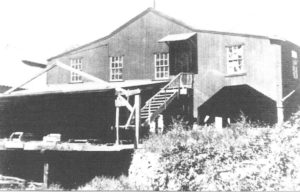
The Old Sawmill
By Dan Shine
Voice Columnist
Our area has many locations with mysterious names that bear reference to days gone by: Long Wharf, Campbell Avenue, Wind Sock Road, Bull Hill Lane, Annawon Avenue, Sawmill Road, Captain Thomas Boulevard, and others. What were their stories? Well, here’s one:
In the late 19th Century, West Haven’s expanding service to the shipbuilding industry created a strong demand for a great many ship masts and large amounts of planking and timbers. At that time, our forests still offered large stands of old-growth forest and tall timber. In fact, when the first white settlers came here in the 1630s, they found 96 percent of Connecticut covered in old growth forest. About half of those trees were American chestnuts, and it was common to find immense oak trees and majestic pines. Within 200 years, these forests had been reduced to cover only 20 percent of Connecticut, and a variety of ecological problems had begun to spring up.
But still, lumber was needed for housing and shipbuilding and so trees were felled and dragged with chains over the dirt roads by teams of draft horses with heavy harnesses. They were taken to the old red sawmill which stood by the stream that passes today’s Interstate 95, at Exit 42.
There, logs were cut into planks and timbers using a pit saw, as records indicate, and it was done like this: two men called Sawyers positioned themselves, one above and one below a horizontally-placed log. They held opposite ends of a whipsaw, which was drawn up and down through the log with the normal reciprocating motion.
For the Sawyers, it was miserable, backbreaking work; and by necessity it was very exacting, since the planks and timbers had to follow uniform dimensions in order to be useful. And especially for the sawyer below, it was dusty work. However, a day of ripping oak trees into boards would produce a useful by-product—buckets full of oaken sawdust that was gathered and burned to aid the process of curing bacon.
The first saw pit had been devised in the 13th Century, and was eventually replaced by the use of water power: in the 1500s, a Dutch inventor realized that by applying a pitman arm—or crank–to the shaft of a waterwheel he could create the reciprocating motion necessary to saw the wood without the work of sawyers. However, existing records do not indicate whether or not water power was ever used in the West Haven sawmill.
After the logs were processed into lumber, much of it was sent to the H.H. Richards Lumber Company on Water Street. From there, the Richards brothers sold the wood necessary for the construction of many homes and ships. Eventually, both the sawmill and the lumber yard ceased their operation in the early 20th Century.
Sadly, today no trace remains of the old sawmill, and this is indeed our loss; but at least now its story is told.